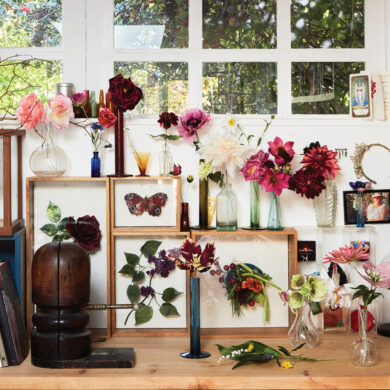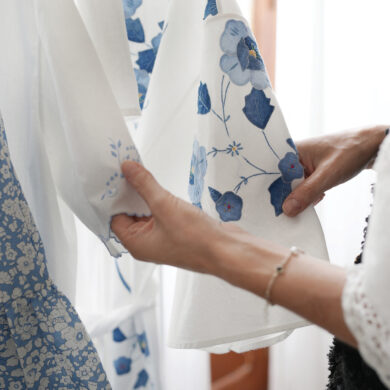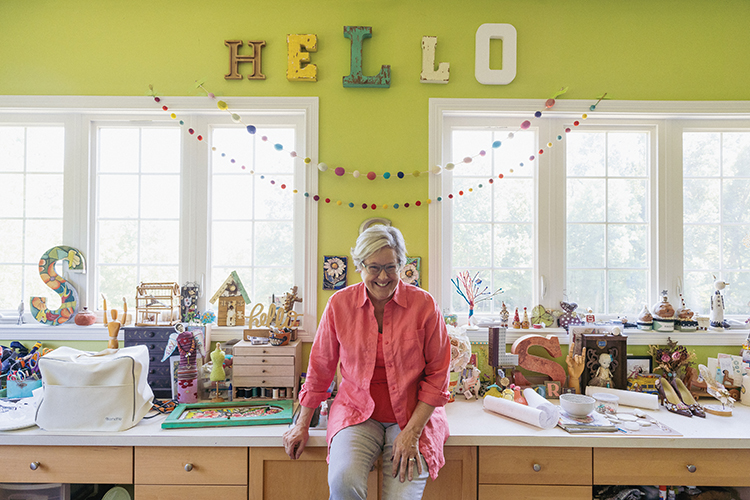
FROM LORI SIEBERT:
I have been hosting creative challenges every other month on Instagram for the last two years. The themes, prompts, co-hosts and judges are different each time. One challenge that has been repeated several times is the “Coloricombo Challenge.” The amazing artist Esté MacLeod hosts this challenge all year long in her community, and I co-host with her on IG a couple months a year.
Artist Suzanne Breeze was selected by WHERE Women Create as a winner for one of these challenges. Her work is uniquely her. Each beautifully colored image tells a little story. Congrats, Suzanne!
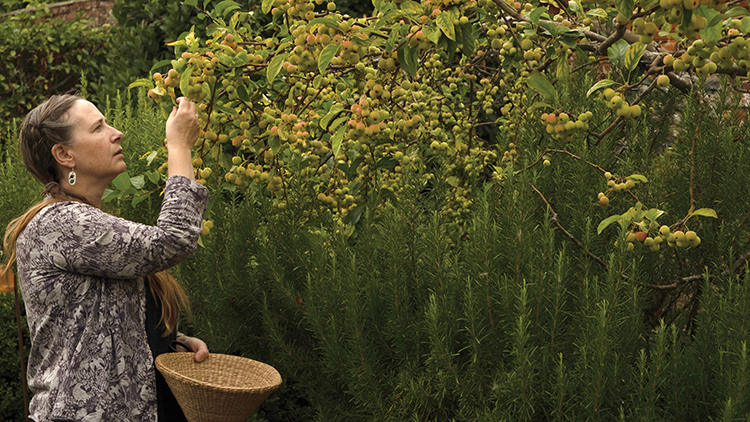
If you asked me 10 years ago what my life would be like at this point in time, I do not think I would be anywhere near the right answer. I studied graphic design, specialising in illustration, back in the late 1980s. I left art school at the age of 21, completely ill-equipped to start out on a solo career as a self-employed illustrator. I had been trained to be an artist, but running your art as a business is a whole other skillset, and in the early ’90s, the illustration trade was pretty much nonexistent.
The fashion back then, at least in the U.K., was for Dorling-Kindersley photography (makers of the DK reference books). I couldn’t envision a space for myself within the industry. I had no direction. I drifted into retraining as a counsellor and worked with Age Concern and various other London-based projects until the birth of my first child. Then, for many years, I was pretty much a full-time mother.
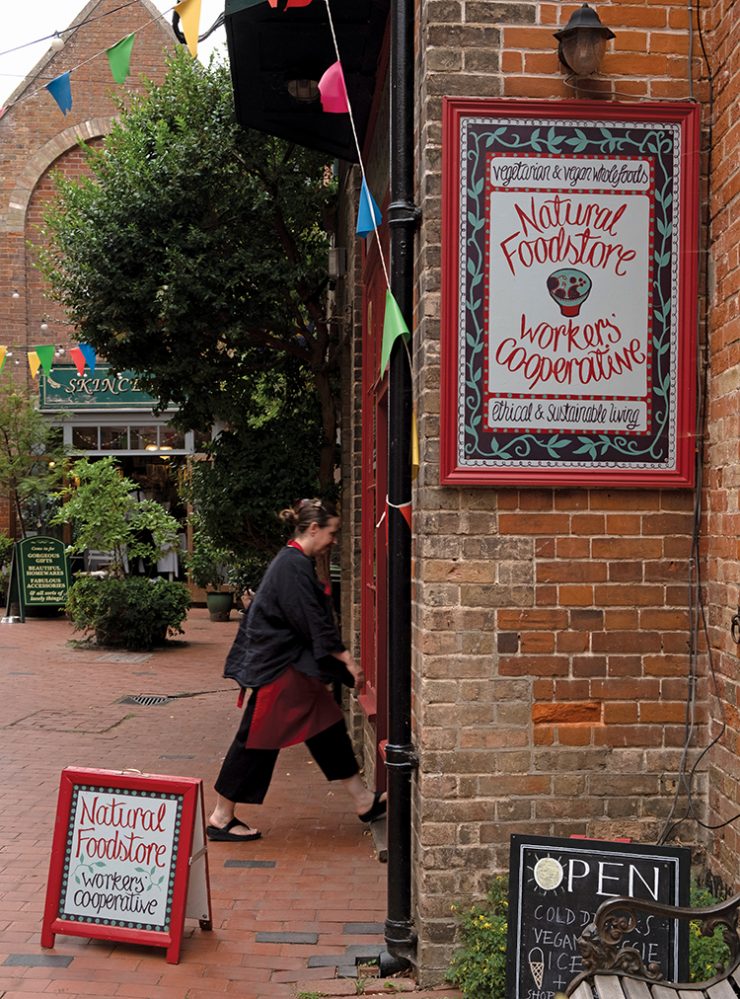
My relationship with drawing and painting took a bashing. My inability to forge a path as a professional artist, or even begin to find a way into the industry had, I think in hindsight, soured my relationship with my creativity. I felt ashamed, for years, for not continuing my art practice. Drawing had been my passion throughout childhood and adolescence, yet my inability to be an entrepreneur became confused with the work, and I saw that part of myself as a failure. Homemaking, parenting, gardening and sewing absorbed my creativity.
When my two oldest children were both at school, I started working part time in a local vegetarian wholefood store. I worked there on and off for 15 years. When the owner of the business wanted to retire, she asked the staff members if anyone wanted to take it on. No one was in a position to do this individually, but we were all very proud of the shop, proud of the role it played in the community and proud of what it stood for. It had been ahead of its time, in operation since the mid 1970s; it was a force for good within the community, with a sustainable ethos, local suppliers and organic produce.
My colleagues and I felt strongly that we did not want to lose the shop or our jobs, so we banded together and formed a workers’ cooperative. We crowdfunded to raise the money to buy the business and received a huge, heartwarming amount of support from our customers. In 2017, we bought the business and took over. We started to redecorate. We beautified the windows and painted the ethos throughout the store in order to explain our passion for what we were selling. We were making our mark on the business and letting our customers and potential customers see how much we cared.
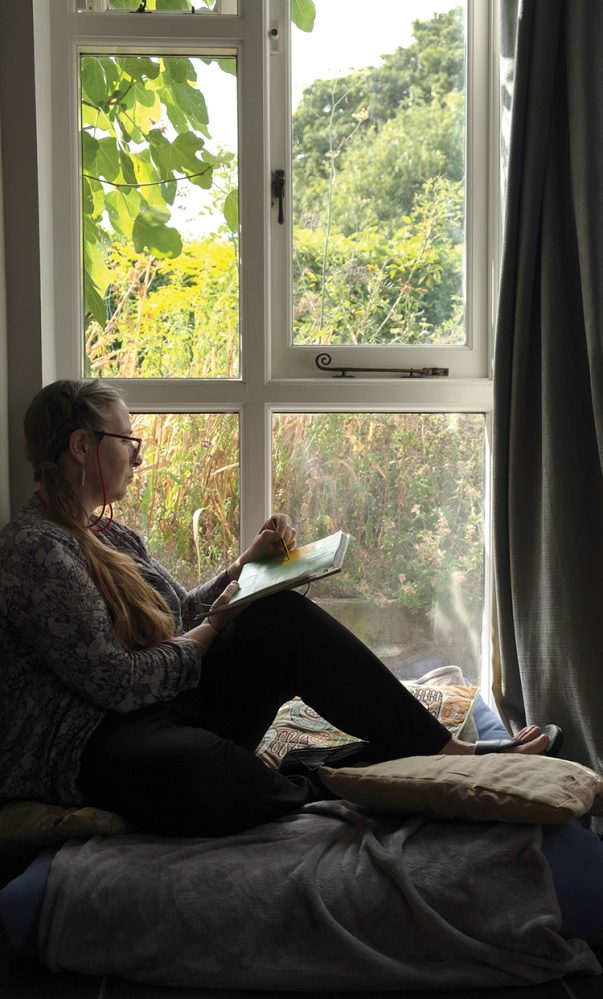
While all this was happening, my 30-year relationship with my husband was falling apart. I was approaching 50 years old and two of my children had left for university and lives of their own. Basically, I was at my lowest ebb. My self-esteem had hit rock bottom, and grief and anxiety were constantly present.
However, with the support of my colleagues, my friends and my children, and having a business that needed growing, I began to find a way to move forward. My illustration and design talents were called upon. I learned about social media, Instagram, Facebook. I learned new roles within the business — product design, signwriting and branding, ordering stock, accounting and spreadsheets! I was appreciated by my colleagues, and I felt useful and creative. I started to see myself in a more positive way and started to value myself again. I had a position in a team where I could flourish and had found a knack for entrepreneurship that I didn’t have when I was 21.
“IF YOU’RE GOING TO BE AN ARTIST, YOU’VE GOT TO MAKE YOUR WORK YOUR BEST FRIEND, THAT YOU CAN GO TO WHATEVER YOU’RE FEELING AND HAVE A CONVERSATION WITH IT.”
— Maggi Hambling
The creativity of growing the shop kickstarted something within me, and I felt my energy levels growing. I started to draw and paint again. Making art had been unobtainable for so many years. Now I was doing it in earnest. It helped me to build myself up again and distracted me from my grief. It helped me to be in the moment, and I believe it has helped to keep me sane and recover from a horrible time.
For years I had felt there was no time for me to make art, and I did not deserve the time or space it took to make it, as I was not able to monetise or prove it was worthwhile. With only one teenager left to care for, suddenly I had whole evenings and weekends to myself. I learned to take this time for myself; my art practice grew, as did my confidence in my work.
Running the shop alongside my amazingly supportive colleagues has helped me see how building a business is a creative process and a fun challenge. Finding that I was capable of something like this gave me the final push back into painting and drawing, that creative urge I had been partially ignoring for nearly 30 years.
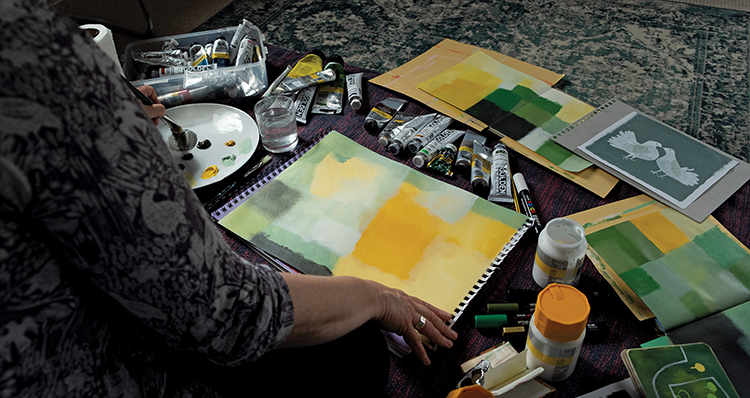
I am still not sure how to be a professional artist. I am always anxious about the next step forward, but now I try to draw every day. Even if it is just for a few minutes. Starting is the key. If it is a workday, I aim to go to bed at about 9 p.m., put on a story tape or podcast, take up my sketchbook or drawing pad and start. I love to make art now. My pleasure in it has returned. For the first time in my adult life, I can make art for the sheer joy of it. I am so relieved that I have found a way to live that gives me space to make time for art.
I feel as though a light bulb has been turned back on. I do not know if I will find a way for my art practice to make money, even if it is just to cover the cost of the materials, but this is not stopping me from working. My relationship with making art has definitely taken a turn for the better. My skills were needed. I realised the act of drawing was healing and then, through frequent practice, I started to make work that felt meaningful.
“THE JOB OF A STORYTELLER IS TO SPEAK THE TRUTH. BUT WHAT WE FEEL MOST DEEPLY CAN’T BE SPOKEN IN WORDS ALONE. AT THIS LEVEL, ONLY IMAGES CONNECT. AND HERE, STORY BECOMES SYMBOL; SYMBOL IS MYTH. AND MYTH IS TRUTH.”
— Alan Garner
I have discovered that I have an aversion to the white page. I started to paint loose sheets of paper with a base colour of acrylic — a “grounding.” My sketchbook pages have the same treatment. Because a lot of my artmaking time was in the evenings, I needed to find a way to work with colour when the light was not good. I would work with paint during daylight hours, then draw with pencil or work in collage when I only had electric light.
I work with tissue paper coloured with printing inks, and recently I discovered Posca Pens. These are very useful for working in the evenings. I like to paint with acrylic, and Posca pens contain acrylic paint. Acrylic paint pens work well with mixed-media work and give me a level of control. Acrylic paint can be thinned and thickened. It can become textural, and the layering of colours is possible. I am enjoying exploring it as a medium.
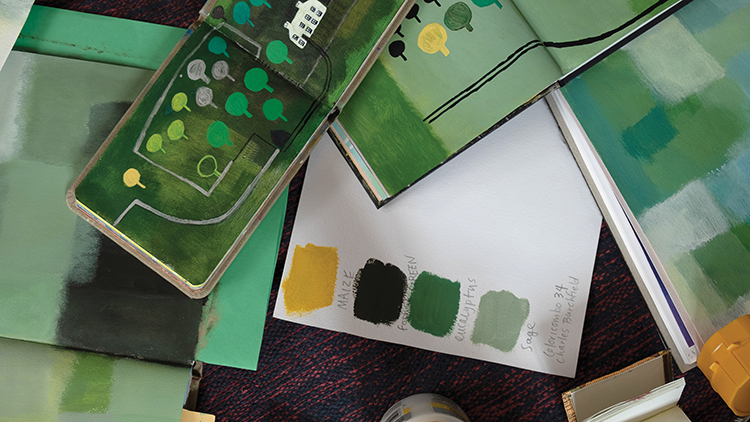
I love to combine drawing with painting. I am a big fan of the 4B pencil. My favourite sketchbook is a Clairefontaine Goldline, as they lay flat and have nice thick paper that works well for mixed-media work. I always have at least three sketchbooks on the go at once. I finish one drawing in one book and then use it as inspiration to start the next in another book. It is a little like a conversation. I will look through the painted pages and find a page I want to work on.
Colour is always the starting point for me, which is why beginning with a “grounding” is so effective for unlocking the page. I have always sketched and drawn from life, but I have also worked from memory and imagination. Myths, folktales and stories are important to me.
The work I am making at the moment is coming from this place — memory and dreams, too. Definitely a sense of place. Houses glimpsed through foliage. Imaginary landscapes with interlinked cottages and tiny sailing dinghies. Animals wandering in and out. Often the landscapes morph into pattern and then return to landscape again. There is a sense of storytelling there, though I only feel the story; I do not have words to convey it.
I still don’t know what I’m doing, but I am doing it, and I know something important is happening.
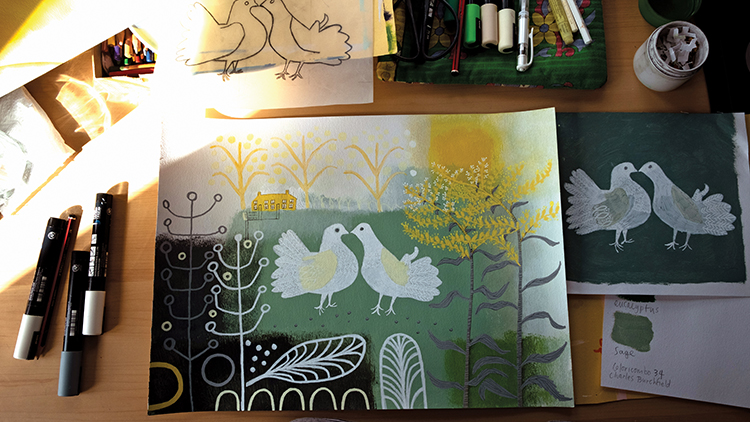

FROM LORI SIEBERT:
I have been hosting creative challenges every other month on Instagram for the last two years. The themes, prompts, co-hosts and judges are different each time. One challenge that has been repeated several times is the “Coloricombo Challenge.” The amazing artist Esté MacLeod hosts this challenge all year long in her community, and I co-host with her on IG a couple months a year.
Artist Suzanne Breeze was selected by WHERE Women Create as a winner for one of these challenges. Her work is uniquely her. Each beautifully colored image tells a little story. Congrats, Suzanne!

If you asked me 10 years ago what my life would be like at this point in time, I do not think I would be anywhere near the right answer. I studied graphic design, specialising in illustration, back in the late 1980s. I left art school at the age of 21, completely ill-equipped to start out on a solo career as a self-employed illustrator. I had been trained to be an artist, but running your art as a business is a whole other skillset, and in the early ’90s, the illustration trade was pretty much nonexistent.
The fashion back then, at least in the U.K., was for Dorling-Kindersley photography (makers of the DK reference books). I couldn’t envision a space for myself within the industry. I had no direction. I drifted into retraining as a counsellor and worked with Age Concern and various other London-based projects until the birth of my first child. Then, for many years, I was pretty much a full-time mother.

My relationship with drawing and painting took a bashing. My inability to forge a path as a professional artist, or even begin to find a way into the industry had, I think in hindsight, soured my relationship with my creativity. I felt ashamed, for years, for not continuing my art practice. Drawing had been my passion throughout childhood and adolescence, yet my inability to be an entrepreneur became confused with the work, and I saw that part of myself as a failure. Homemaking, parenting, gardening and sewing absorbed my creativity.
When my two oldest children were both at school, I started working part time in a local vegetarian wholefood store. I worked there on and off for 15 years. When the owner of the business wanted to retire, she asked the staff members if anyone wanted to take it on. No one was in a position to do this individually, but we were all very proud of the shop, proud of the role it played in the community and proud of what it stood for. It had been ahead of its time, in operation since the mid 1970s; it was a force for good within the community, with a sustainable ethos, local suppliers and organic produce.
My colleagues and I felt strongly that we did not want to lose the shop or our jobs, so we banded together and formed a workers’ cooperative. We crowdfunded to raise the money to buy the business and received a huge, heartwarming amount of support from our customers. In 2017, we bought the business and took over. We started to redecorate. We beautified the windows and painted the ethos throughout the store in order to explain our passion for what we were selling. We were making our mark on the business and letting our customers and potential customers see how much we cared.

While all this was happening, my 30-year relationship with my husband was falling apart. I was approaching 50 years old and two of my children had left for university and lives of their own. Basically, I was at my lowest ebb. My self-esteem had hit rock bottom, and grief and anxiety were constantly present.
However, with the support of my colleagues, my friends and my children, and having a business that needed growing, I began to find a way to move forward. My illustration and design talents were called upon. I learned about social media, Instagram, Facebook. I learned new roles within the business — product design, signwriting and branding, ordering stock, accounting and spreadsheets! I was appreciated by my colleagues, and I felt useful and creative. I started to see myself in a more positive way and started to value myself again. I had a position in a team where I could flourish and had found a knack for entrepreneurship that I didn’t have when I was 21.
“IF YOU’RE GOING TO BE AN ARTIST, YOU’VE GOT TO MAKE YOUR WORK YOUR BEST FRIEND, THAT YOU CAN GO TO WHATEVER YOU’RE FEELING AND HAVE A CONVERSATION WITH IT.”
— Maggi Hambling
The creativity of growing the shop kickstarted something within me, and I felt my energy levels growing. I started to draw and paint again. Making art had been unobtainable for so many years. Now I was doing it in earnest. It helped me to build myself up again and distracted me from my grief. It helped me to be in the moment, and I believe it has helped to keep me sane and recover from a horrible time.
For years I had felt there was no time for me to make art, and I did not deserve the time or space it took to make it, as I was not able to monetise or prove it was worthwhile. With only one teenager left to care for, suddenly I had whole evenings and weekends to myself. I learned to take this time for myself; my art practice grew, as did my confidence in my work.
Running the shop alongside my amazingly supportive colleagues has helped me see how building a business is a creative process and a fun challenge. Finding that I was capable of something like this gave me the final push back into painting and drawing, that creative urge I had been partially ignoring for nearly 30 years.

I am still not sure how to be a professional artist. I am always anxious about the next step forward, but now I try to draw every day. Even if it is just for a few minutes. Starting is the key. If it is a workday, I aim to go to bed at about 9 p.m., put on a story tape or podcast, take up my sketchbook or drawing pad and start. I love to make art now. My pleasure in it has returned. For the first time in my adult life, I can make art for the sheer joy of it. I am so relieved that I have found a way to live that gives me space to make time for art.
I feel as though a light bulb has been turned back on. I do not know if I will find a way for my art practice to make money, even if it is just to cover the cost of the materials, but this is not stopping me from working. My relationship with making art has definitely taken a turn for the better. My skills were needed. I realised the act of drawing was healing and then, through frequent practice, I started to make work that felt meaningful.
“THE JOB OF A STORYTELLER IS TO SPEAK THE TRUTH. BUT WHAT WE FEEL MOST DEEPLY CAN’T BE SPOKEN IN WORDS ALONE. AT THIS LEVEL, ONLY IMAGES CONNECT. AND HERE, STORY BECOMES SYMBOL; SYMBOL IS MYTH. AND MYTH IS TRUTH.”
— Alan Garner
I have discovered that I have an aversion to the white page. I started to paint loose sheets of paper with a base colour of acrylic — a “grounding.” My sketchbook pages have the same treatment. Because a lot of my artmaking time was in the evenings, I needed to find a way to work with colour when the light was not good. I would work with paint during daylight hours, then draw with pencil or work in collage when I only had electric light.
I work with tissue paper coloured with printing inks, and recently I discovered Posca Pens. These are very useful for working in the evenings. I like to paint with acrylic, and Posca pens contain acrylic paint. Acrylic paint pens work well with mixed-media work and give me a level of control. Acrylic paint can be thinned and thickened. It can become textural, and the layering of colours is possible. I am enjoying exploring it as a medium.

I love to combine drawing with painting. I am a big fan of the 4B pencil. My favourite sketchbook is a Clairefontaine Goldline, as they lay flat and have nice thick paper that works well for mixed-media work. I always have at least three sketchbooks on the go at once. I finish one drawing in one book and then use it as inspiration to start the next in another book. It is a little like a conversation. I will look through the painted pages and find a page I want to work on.
Colour is always the starting point for me, which is why beginning with a “grounding” is so effective for unlocking the page. I have always sketched and drawn from life, but I have also worked from memory and imagination. Myths, folktales and stories are important to me.
The work I am making at the moment is coming from this place — memory and dreams, too. Definitely a sense of place. Houses glimpsed through foliage. Imaginary landscapes with interlinked cottages and tiny sailing dinghies. Animals wandering in and out. Often the landscapes morph into pattern and then return to landscape again. There is a sense of storytelling there, though I only feel the story; I do not have words to convey it.
I still don’t know what I’m doing, but I am doing it, and I know something important is happening.










